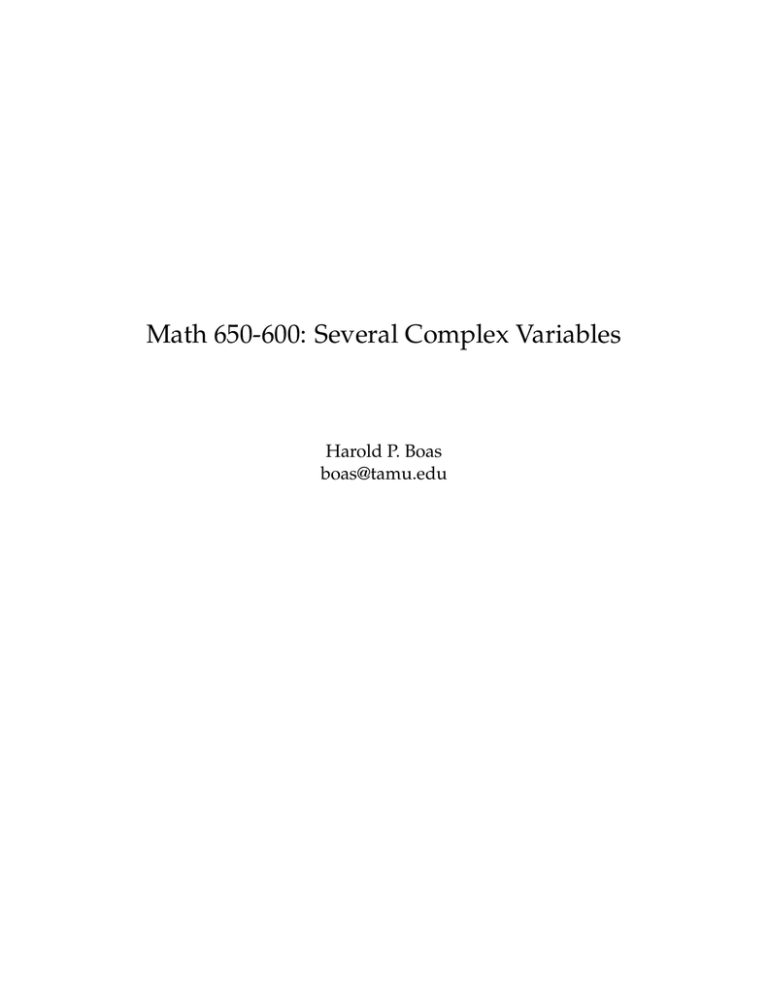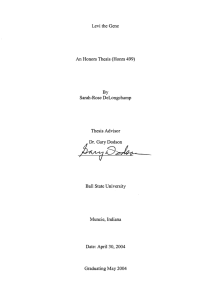Math 650-600: Several Complex Variables Harold P. Boas
advertisement

Math 650-600: Several Complex Variables
Harold P. Boas
boas@tamu.edu
The Levi form
Suppose that (locally) Ω is { z ∈ Cn : ρ(z) < 0 }, where ρ is a twice-differentiable, real-valued
function, and ∇ρ 6= 0 where ρ = 0. Equivalently, Ω is locally the graph of a twice-differentiable
function (by the implicit function theorem).
Theorem. Pseudoconvexity is equivalent to the property that for each boundary point a of Ω,
n
∂2 ρ
∑ ∂z j ∂zk (a)t j tk ≥ 0
j,k=1
for every complex tangent vector t.
A complex tangent vector t satisfies the equation
n
∂ρ
∑ ∂z j (a)t j = 0.
j=1
Math 650-600
April 5, 2005 — slide #2
From pseudoconvexity to the Levi form
One choice of a local defining function is the signed distance function ρ(z) = − dist(z, bΩ)
when z ∈ Ω and ρ(z) = + dist(z, bΩ) when z ∈ Cn \ Ω.
We know that if Ω is pseudoconvex, then − log(−ρ) is plurisubharmonic inside Ω, which
means that
n
∂ρ
1 n
∂2 ρ
1 n ∂ρ
tj ∑
t ≥0
t j tk + 2 ∑
∑
|ρ| j,k=1 ∂z j ∂zk
ρ j=1 ∂z j k=1 ∂zk k
for every vector t in Cn .
Restricting to vectors t for which ∑nj=1 ∂z t j = 0 gives that ∑nj,k=1
j
taking the limit at the boundary shows that the Levi form is ≥ 0.
∂ρ
Math 650-600
∂2 ρ
∂z j ∂zk t j t k
≥ 0 inside Ω, and
April 5, 2005 — slide #3
The converse direction
Suppose the Levi form is ≥ 0 on complex tangent vectors to the boundary of Ω. The goal is to
show that Ω has a plurisubharmonic exhaustion function locally.
Choose ρ of the form ϕ(z1 , . . . , zn−1 , xn ) − yn in local coordinates. Then the Levi condition
n
∂2 ρ
∑ ∂z j ∂zk (a)t j tk ≥ 0
j,k=1
whenever
n
∂ρ
∑ ∂z j (a)t j = 0
j=1
holds for all points a in (a local coordinate patch of) Ω, not just for boundary points. We need
additionally to control the size of the complex Hessian in the missing direction.
Resolve an arbitrary vector t as a sum t 0 + t00 , where ∑nj=1
¯
¯ n ∂ρ
¯/|∂ρ|.
¯∑
(a)t
j
j=1 ∂z j
∂ρ
0
∂z j (a)t j
Math 650-600
= 0 and |t00 | =
April 5, 2005 — slide #4
Conclusion of the proof
n
∂2 ρ
∑ ∂z j ∂zk (a)t j tk =
j,k=1
n
∂2 ρ
0
∑ ∂z j ∂zk (a)t0j tk + O(|t| · |t00 |),
j,k=1
and the first term is ≥ 0 by ¯hypothesis, ¯so there is constant C such that
n
¯
¯ n ∂ρ
∂2 ρ
∑ ∂z j ∂zk (a)t j tk ≥ −C|t| · ¯¯ ∑ ∂z j (a)t j ¯¯.
j=1
j,k=1
The complex Hessian of − log(−ρ) applied to t is then
¯
¯
¯2
¯ n
¯
¯
¯
1
−C|t| ¯¯ n ∂ρ
∂ρ
≥
· ¯∑
(a)t j ¯¯ + 2 · ¯¯ ∑
(a)t j ¯¯ ≥ −B|t|2
|ρ|
∂z j
∂z j
ρ
j=1
j=1
for some constant B (namely B = C 2 /4).
Then − log(−ρ(z)) + B|z|2 is a local plurisubharmonic function that blows up at the boundary
of Ω. Thus Ω is pseudoconvex when the Levi form of Ω is ≥ 0.
Math 650-600
April 5, 2005 — slide #5
Exercises on the Levi form
1. Positivity of the Levi form is independent of the choice of defining function.
2. Use the chain rule to show that positivity of the Levi form is invariant under holomorphic
changes of coordinates.
In other words, if F = ( f 1 , . . . , f n ) is a (local) biholomorphic mapping, then the Levi form of ρ
is ≥ 0 if and only if the Levi form of ρ ◦ F is ≥ 0.
Part of the problem is to verify that the complex tangent space is preserved under biholomorphic mappings.
Math 650-600
April 5, 2005 — slide #6





